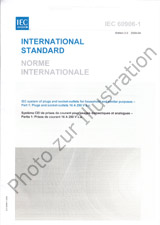Wir benötigen Ihre Einwilligung zur Verwendung der einzelnen Daten, damit Sie unter anderem Informationen zu Ihren Interessen einsehen können. Klicken Sie auf "OK", um Ihre Zustimmung zu erteilen.

IEC/IEEE 62704-3-ed.1.0
Determining the peak spatial-average specific absorption rate (SAR) in the human body from wireless communications devices, 30 MHz to 6 GHz - Part 3: Specific requirements for using the finite difference time domain (FDTD) method for SAR calculations of mobile phones
Name übersetzen
NORM herausgegeben am 26.10.2017
Informationen über die Norm:
Bezeichnung normen: IEC/IEEE 62704-3-ed.1.0
Ausgabedatum normen: 26.10.2017
SKU: NS-800342
Zahl der Seiten: 72
Gewicht ca.: 216 g (0.48 Pfund)
Land: Internationale technische Norm
Kategorie: Technische Normen IEC
Kategorie - ähnliche Normen:
Die Annotation des Normtextes IEC/IEEE 62704-3-ed.1.0 :
IEC/IEEE 62704-3:2017 defines the concepts, techniques, benchmark phone models, validation procedures, uncertainties and limitations of the finite difference time domain (FDTD) technique when used for determining the peak spatial-average specific absorption rate (SAR) in standardized head and body phantoms exposed to the electromagnetic fields generated by wireless communication devices, in particular pre-compliance assessment of mobile phones, in the frequency range from 30 MHz to 6 GHz. It recommends and provides guidance on the numerical modelling of mobile phones and benchmark results to verify the general approach for the numerical simulations of such devices. It defines acceptable modelling requirements, guidance on meshing and test positions of the mobile phone and the phantom models. This document does not recommend specific SAR limits since these are found in other documents, e.g. IEEE C95.1-2005 and ICNIRP Key words: Mobile Phone, Spatial-Average Specific Absorption Rate, Finite-Difference Time-Domain, Human Body IEC/IEEE 62704-3:2017 definit les concepts, techniques, modeles de telephones de reference, procedures de validation, incertitudes et limites de la methode des differences finies dans le domaine temporel (FDTD) lorsquils permettent de determiner le debit dabsorption specifique (DAS) maximal moyenne dans les fantomes normalises de la tete et du corps exposes aux champs electromagnetiques engendres par les dispositifs de communication sans fil, notamment levaluation de preconformite des telephones mobiles, dans la plage de frequences comprises entre 30 MHz et 6 GHz. Le present document recommande et fournit un guide sur la modelisation numerique des telephones mobiles, ainsi que des resultats de reference qui permettent de verifier lapproche generale des simulations numeriques de ces dispositifs. Il specifie des exigences de modelisation et un guide acceptables sur le maillage et les positions dessai des modeles de telephones mobiles et de fantomes. Le present document ne recommande pas de valeurs limites de DAS specifiques dans la mesure ou celles-ci peuvent etre consultees dans dautres documents, par exemple, IEEE C95.1-2005[1] et ICNIRP[2]. Mots cles: telephones mobiles, debut dabsorption specifique maximal moyenne, differences finies dans le domaine temporel, corps humain
Empfehlungen:
Aktualisierung der technischen Normen
Wollen Sie sich sicher sein, dass Sie nur die gültigen technischen Normen verwenden?
Wir bieten Ihnen eine Lösung, die Ihnen eine Monatsübersicht über die Aktualität der von Ihnen angewandten Normen sicher stellt.
Brauchen Sie mehr Informationen? Sehen Sie sich diese Seite an.



 Cookies
Cookies
